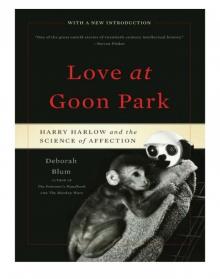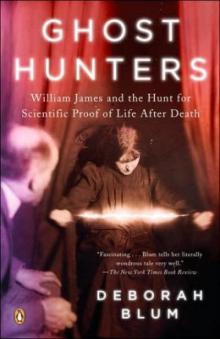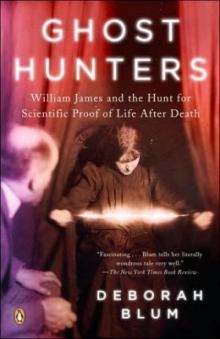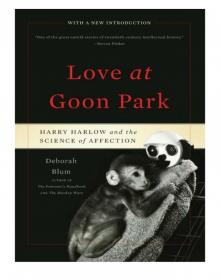- Home
- Deborah Blum
Love at Goon Park: Harry Harlow and the Science of Affection Page 13
Love at Goon Park: Harry Harlow and the Science of Affection Read online
Page 13
Harry hadn’t at first realized how smart the macaques were. Their ability to adapt is, like ours, based partly on a quick, calculating mind. Today, primatologists have shown that rhesus macaques can do simple math equations and play shoot-the-target arcade games with astonishing accuracy—far beyond that which even Harry Harlow expected. So Harry was lucky twice over. He was lucky to have had so few monkeys and lucky that the monkeys he could get were mostly rhesus macaques. And later, when he went on to study love and connection, he would find himself lucky again. Because rhesus macaques are also, like us, among the most passionately connected species on the planet. Once again, they would help make Harry Harlow a psychologist with the right animal at the right time.
The first tests with the WGTA were straightforward. Most intelligence tests that people take are written. A few tests, for young children and brain-damaged adults, are administered with pictures or objects—a picture of a block, an actual block. Goldstein had helped develop such tests. The monkey tests were all based on objects set out on those interchangeable trays. For example, a monkey is shown a board or tray that holds two objects. Let’s say there’s a fat blue cube and a long green rectangle. The board is flat but there are regularly spaced hollows in it—as with the board of the African stone game, Mancala.
Researchers call those hollows “food wells.” The experimenter can put the cube and rectangle on top of the well to hide food or treats within. If the monkey picks up the “right” object, say, the cube, it finds raisins or peanuts underneath. Under the rectangle, no such luck. Essentially, finding the treat provides the clue to the right answer. The cube and rectangle are moved around the board here and there, to the corners, in the middle, to make completely meaningless patterns, and the monkey has to try again to pick up the right object. The cube. The cube. The cube again. Trial after trial until he always grabs, yes, the cube.
And then a new trial, and now it’s the rectangle. Or there’s a new pattern, a blue ball and a spiky purple cross. This time it’s the cross. And then a different trial. And a different trial.
So how did the few monkeys, picking up blocks over and over, become important? If this was only trial and error, then each time the scientists changed the pattern, the animal should go through a comparable fumbling process toward the answer. If it took it thirty trials to get the cube every time, then it should take the same thirty or so trials when a researcher changed to the rectangle or the cross or the ball. But that wasn’t what happened. Instead, the monkeys got faster and faster, and more and more accurate. After a monkey had spent some time in Harry’s lab—and that could mean hundreds of tests in a week or so—it could figure out the pattern within one or two tries. If the treat was under the blue cube, that was the answer. If during the next test the blue cube produced nothing, but there was good stuff under the red triangle, the monkey would rethink. At first, the animal might take a few trials to recognize the switch, maybe six or so. But the more experienced monkeys could shift from cube to triangle after one mistake, almost as fast as the scientists could change the trays. “Eventually, the monkey showed perfect insight when faced with this kind of situation—it solved the problem in one trial. If it chose the correct object on the first trial, it rarely made an error in subsequent trials.” And if it did pick the wrong object, it immediately changed over. As Harry put it: “This is not a vague something-or-other but a definite and measurable concept on the part of the learner as to what is being learned. It is the point at which a child might say, ‘Oh, I’m supposed to add these numbers and I know how to do that.’”
In fact, the animals were starting to make this look too easy. Harry and his students decided to make the challenge harder. Now they offered the monkeys a choice among three objects. Harry called this an “oddity trial,” and it was the kind of test that Goldstein believed could prove analytical ability. The tray now contained three food wells, two covered by matching objects and the third covered by a misfit object. In these tests, only the odd object sits on top of food. So let’s say that in the first test there are two blocks and a funnel. The animal must choose the funnel. Then the scientists switch it—two funnels and a block. Now, the correct object is the block. There’s a subtle and important distinction here that the animal must understand: It is not the shape of the object that is important, but its relation to the other two objects. In the first test, the funnel shape means odd one out. In the second, the funnel shape means matched set. The problem of shapes and relationships is complicated because it demands an ability to analyze relationships. And, again, this turned out to be no problem. After a short period of puzzled experimenting, Harry’s monkeys again came through like stars on the oddity trials.
They were so good that Harry started wondering about another comparison: monkeys versus humans. How would his bright-eyed macaques compare to other beginners on these kinds of tests? Say, for instance, young children? He became so intrigued by that idea that he recruited a child psychologist to work with him, an upcoming new faculty member named Margaret Kuenne (pronounced KEENEE). She arranged for a group of children to try solving the same kinds of block-and-funnel problems. The children were rewarded with beads and small toys rather than peanuts and raisins. The researchers deliberately decided to select smart children. Peggy Kuenne put together a group of seventeen children, aged two to five, who had relatively high IQs, between 109 and 151. The children had no previous experience with oddity testing. Both children and monkeys were then asked to solve puzzles. Both groups fumbled through the first few problems, but they gradually recognized the pattern and whizzed through the later tests with near perfection. “Sometimes the monkeys were better, especially early on. Once both were trained, the children were almost always faster at picking up the pattern but the process was basically the same,” Harry wrote. He was definitely making his case that monkeys shared analytical abilities with humans. He wondered, though, whether he had even yet pushed the animals as far as they could go.
If the monkeys could understand relationships between related objects, could they understand even more subtle symbolism? Harry and his students laid out a complicated series of relationships on the WGTA trays. Now the color of the tray mattered. On one test, the tray contained three objects: a red U-shaped block, a green U-shaped block, and a red cross-shaped block. If the tray was orange, the monkeys had to choose the green block, recognizing that it was the odd one out in color. But if the tray was cream-colored, the monkeys had to choose the cross, the odd one in shape. This was not something the monkeys did first time out, obviously; but with practice, wrote Harry, “after the monkeys had formed these two learning sets, the color cue of the tray enabled them to make the proper choice, trial after trial, without error.”
This was exactly the kind of problem that Goldstein had found was so difficult for people suffering brain damage. And now Harry started thinking again about the absurdity of setting limits on the brain. His WGTA monkeys were learning, becoming smarter with education. The academically challenging life of these monkeys seemed to be extending their natural abilities. So what if Harry took on Goldstein even more directly? If monkeys with a whole and healthy brain could gain analytical skills, what about brain-damaged monkeys? Could the injured brain also have the potential to improve? Harry happened to have some animals that might be just right for trying out this newly heretical idea.
Several monkeys in his laboratory were left over from a study of brain anatomy. These monkeys had lost one of their two brain hemispheres from an early effort to explore the right versus the left hemisphere. Due to his monkey-hoarding principles, Harry had kept these animals well fed and healthy. He decided to put the half-brained monkeys into the WGTA tests. Again, because he had only a few of them, these “hemidecorticate” animals learned the lessons of the trays and the objects and the shapes and the colors over and over again. And, against all the predictions, they became measurably educated monkeys. Although the half-brained monkeys were slower than their peers, they still gained speed an
d accuracy as they rotated through the test trays.
Harry’s team compared the “educated” half-brained monkeys to uneducated but intact macaques. For a brief shining period, until the new monkeys were also well educated, the brain-damaged animals looked smarter. In the early comparisons, they were far faster at the tasks. “It would appear that in this situation, half a brain is better than one, if the trained half-brain is compared to the untrained whole one,” Harry wrote. He went on to speculate that there could be the possibility of therapy in these results. “More seriously, these data may indicate why educated people show less apparent deterioration with advancing age than uneducated individuals.” As an educated man, Harry appreciated the idea, but it was another point that he thought more important. His results emphasized to him that no one is simply born brilliant: “The brain is essential to thought, but the untutored brain is not enough, no matter how good it may be.”
It was an absolutely wonderful idea—that we all had promise, we all had the potential to be coaxed out by the right teacher, or home, or even laboratory. If our brains weren’t good enough, they just hadn’t yet received what they needed. For all that it was a B. F. Skinner–approved apparatus, Harry’s WGTA ended up as pure counterculture in its results. It didn’t show conditioning at all. It showed learning. Harry’s monkeys didn’t look anything like bar-pressing rats or target-pressing pigeons. Naturally, the results came under attack. And one of the criticisms was troubling. All the animals in these experiments were being given food rewards. Didn’t that make them like Skinner’s pigeons? The monkeys might look sophisticated, but perhaps they were just being conditioned in a different way? If so, there was nothing new here besides Professor Harlow’s fancy ideas.
Now, in a psychology experiment, a food reward is partly a way for a scientist to bridge the communication gap. When testing a human subject, we can give stars or grades to indicate correct answers, we can cheer and congratulate. But how do you tell a monkey that he’s done it correctly? The Wisconsin scientists, in the time-honored tradition of animal research, used food treats. That certainly allowed critics to argue that, despite Harry’s evidence, despite the monkeys’ increasingly adept test taking, the animals were really responding to a food stimulus. There was still room for the interpretation that he was just turning out primates who were well-trained but not especially bright.
If Harry Harlow really wanted to prove that he was demonstrating complex brains at work, he would have to answer that criticism. And so he started thinking about motivation itself. There are certainly the well-trumpeted survival drives—hunger, thirst, shelter, safety. But people, Harry believed, are motivated by other, equally powerful drives. And it’s those other drives that lift us beyond basic existence. We are propelled by emotions such as love or anger, or by that illusive pursuit of happiness. We are driven, too, by a sense of wonder, of exploration, by courage and curiosity. And it was the last of those, the itchy, pushy, irresistible force of curiosity that Harry now began to consider.
He had a story that he particularly liked about the naturally curious monkey. One evening, Harry had been working late at the lab. When he was ready to leave, he remembered that building maintenance had been complaining about lights left on in the empty building. Harry carefully flicked the switches to the off position, went out to the parking lot, got into his car, swung it around to leave—and saw that the lights had flashed back on. He stopped the car, went back in the building, and turned the lights off again. But this time he didn’t go back outside. He just stood there, quietly in the dark, waiting. Abruptly, the lights blazed on again. That was when he caught, out of the corner of his eye, a tail sliding beneath the bars of the nearest cage. It was Grandma, one of his spider monkeys, and she was clearly entertaining herself by flicking on the lights with her long, prehensile tail.
But how had she figured it out? And why? She didn’t receive food or water or strokes for pushing a switch with her tail. Harry was almost as delighted by Granny’s light-flicking maneuvers as he was by the detailed experiments performed with the macaques. If that wasn’t successful curiosity, what was? She’d been curious, she’d figured it out, and her reward was a new skill—and the ability to light up the lab—nothing more or less. It seemed to him that figuring out a puzzle, solving a question, could be its own reward, even for monkeys. The old orangutan, Jiggs, brought this to mind with his passionate desire to master the square-peg dilemma. It had never been food rewards that interested Jiggs. He’d wanted to beat the game. Harry, Peggy Kuenne, who was still working with him on the tests, and his increasingly fascinated crew of students, were finding that food rewards—the bedrock of behaviorist conditioning—often seemed surprisingly irrelevant. At least to primates.
This idea was so heretical that Harry decided once again that they would need an apparatus to pursue it. What they came up with was a mechanical puzzle: a wooden block on which a hasp was restrained by a hook, which was restrained by a pin. The hasp, the hook, and the pin had to be opened in precise sequence to open the puzzle itself. They put together two groups of four monkeys. In one group, each animal was given the puzzle but no rewards. In the second group, each animal was given the puzzle and then rewarded with raisins for a correct move. Conditioned response theory predicted that only the raisin-fed monkeys could be trained to solve the puzzle. But their results went exactly in the opposite direction. The monkeys who were offered no food did stunningly, obviously better.
Put simply, mixing food and puzzles distracted the animals. They were happy enough to get the raisins and peanuts, certainly. But if the monkeys were hungry, they had a hard time focusing on the puzzle. Some of the monkeys grabbed the raisins, stuffed their faces, and then sleepily lost all interest in the challenge. Those who weren’t hungry were happy to get the treat, but they would wedge the fruit into their cheek pouches, saving it, and continue puzzling over the hasps and the pins. The monkeys who solved the puzzle most efficiently were those who had no food distractions. They merely sat down and went to work. You could turn these results over and inside out. There was no way to conclude that the researchers had conditioned a puzzle-solving response into the rhesus macaques.
If you really think about the learning-for-food idea, Harry said, it makes no sense anyway. We’re primates ourselves and if primates learn only to satisfy hunger, then few people in the well-fed United States would have an incentive to learn anything. People and monkeys alike learn because they are curious or interested—and that can be more potent a force, on occasion, than a wish for a second slice of pie. Harry could hardly wait to tell his colleagues about his monkeys, their cheeks puffed out with food treats, still puzzling over a tricky set of locks.
“He had this enormous and contagious enthusiasm for research data being collected in the lab,” says Robert Butler, a postdoctoral researcher at the time and later a professor of psychology at the University of Chicago. When he first came to Harry’s lab, Butler had begun to think that he’d chosen the wrong profession; his early psychology classes seemed completely flat. “I had been wondering why I went for my Ph.D. in psychology. It was so boring. Psychology was so defensive about being a respectable science by doing experimental work. But Harry made you see it differently.”
Harry put Butler to work doing delayed response trials with the WGTA. While he was waiting the proper delayed time period—thirty seconds or so—Butler became curious himself. He started to wonder what the monkeys were doing while they waited for the sliding panel to open. So he added a mirror, angled so that he could watch the animals in their cages. He hadn’t considered that the monkeys could also see him. And he certainly hadn’t considered that it might matter if they did. Suddenly, though, his test results started falling off. The monkeys were fumbling through their challenges. Finally, Butler realized that the monkeys had lost interest in the trays because they were more interested in him. Instead of sorting blocks, they were watching that strange face in the mirror. For all the years that scientists had been finding mo
nkeys fascinating, no one had thought that monkeys might find scientists equally interesting. These monkeys were abandoning the food rewards on the tray just to study a reflection in an angled mirror. Butler started thinking, once again, about the curiosity experiments.
So he built the first scientific testing box for Harry’s laboratory. Butler’s solid-sided box had two moveable windows, one red and one blue. It was designed so that a monkey inside could hear noises outside the box but not see what made them. Would they wonder about what was out there? If the monkey pushed the right window—picked the color correctly—the window would slide open for thirty seconds and he could peer out at the world around him. That glimpse was the only reward for picking the correct color. Did he open the window? Is the earth round?
In one experiment, a monkey persistently raised that colored panel from sunrise until the last grad student left the lab at night. In another test, Butler alternated a plate of delicious fruit outside the window with the chug-and-toot of an electric train. Food was, sure, food; but the train became an obsession. The monkeys studied the fruit with undeniable greed. But the train—so completely strange—riveted them. They couldn’t figure out what it was. They needed just one more look. The windows flew up and down like winking eyelids.
When Butler first proposed the box, Harry was doubtful. But, as Harry frequently said, he was often wrong. That was exactly what Harry told Robert Butler: He thought the box wouldn’t work, but try it anyway. And when Butler ran the tests and the results were electric with curiosity and nothing else, Harry was “ecstatic,” Butler said. The idea was so smart and the results so good that some of Butler’s friends warned him to publish in a hurry. After all, major professors had been known to take credit for their students’ ideas. Instead, Harry plastered Butler’s name all over the findings. He named the device “the Butler box.” “I didn’t name it,” Butler relates. “Harlow named it because he wanted some opposition to the Skinner box.” In Harry’s mind, the Butler box was the perfect counter to rats pressing bars. Butler’s invention demonstrated, without a doubt, that animals were curious. They had thinking minds of their own and they used them, whether researchers dangled food bait in front of them or not.

 Love at Goon Park: Harry Harlow and the Science of Affection
Love at Goon Park: Harry Harlow and the Science of Affection The Poison Squad
The Poison Squad Ghost Hunters: The Victorians and the Hunt for Proof of Life After Death
Ghost Hunters: The Victorians and the Hunt for Proof of Life After Death The Poisoner's Handbook
The Poisoner's Handbook Angel Killer
Angel Killer The Best American Science and Nature Writing 2014
The Best American Science and Nature Writing 2014 The Ghost Hunters
The Ghost Hunters Love at Goon Park
Love at Goon Park